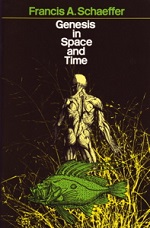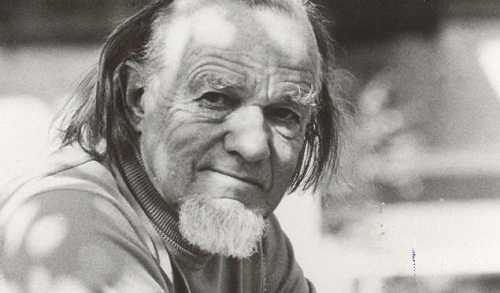 After a unexpectedly long break from my reading and blogging through The Complete Works of Francis Schaeffer, 5 Volumes we are now into the 2nd volume A Christian View of the Bible as Truth. This volume contains Genesis in Space and Time, No Final Conflict, Joshua and the Flow of Biblical History and Basic Bible Studies.
After a unexpectedly long break from my reading and blogging through The Complete Works of Francis Schaeffer, 5 Volumes we are now into the 2nd volume A Christian View of the Bible as Truth. This volume contains Genesis in Space and Time, No Final Conflict, Joshua and the Flow of Biblical History and Basic Bible Studies.
In Genesis in Space and Time, Schaeffer addresses the importance of the first eleven chapters of Genesis as they relate to the flow of Biblical history (a key phrase and concept in this book and Joshua and the Flow of Biblical History). In the first three chapters Schaeffer deals with the six days of creation. Taking cue from Psalms 136, Schaeffer sets the stage for how he interprets Genesis 1-11, as a fact of space-time history.
The opening verse of Genesis, ‘In the beginning God created the heavens and the earth,’ and the remainder of chapter 1 brings us immediately into a world of space and time. Space and time are like warp and woof. Their interwoven relationship is history. Thus the opening sentence of Genesis and the structure of what follows emphasize that we are dealing here with history just as much as if we talked about ourselves at this moment at a particular point of time in a particular geographic place. (7)
With the belief that Genesis 1-11 is presenting space time history there are several important aspects of the narrative that Schaeffer draws out.
First, the beginning of creation does not entail a beginning to God as creator. He must necessarily exist prior to creation itself for it to have a beginning (8). Pointing to Eph. 1:4 & 2 Tim. 1:9 Schaeffer turns our attention to the fact that the Godhead had an eternal relationship before creation. To aid in this discussion Schaeffer chooses the word sequence as opposed to time as it relates to the existence of things and creatures (9, 14). Further, Gen. 1:2 and Jn. 1:1-14 give us clear indication that each member of the Godhead not only existed before creation but also took part in it. Schaeffer has some great discussion on the intricacies of Jn. 1:1-3 as it relates to Christ and His existence before creation and activity at creation (12-14).
Second, the way in which God created is through His spoken word. This is creation by fiat. God as creator is much different then man as creator. While both may conceive of their creation in their minds, God created something from nothing while man creates something out of what already exists. God speaks things into existence and man shapes things into existence. Interestingly enough, Schaeffer briefly touches on the big bang theory stating that he does not feel that it can be owned by the Christian worldview based in Gen. 1. He states
The simple fact is that what is given in Genesis 1:1 has no relationship to the big band theory – because from the scriptural viewpoint, the primal creation goes back beyond the basic material or energy. Even if one accepts the big bang theory, Genesis 1:1 would then go beyond it by saying that God created out of nothing the primal stuff present at the big bang. We have a new thing created by God out of nothing by fiat, and this is the distinction (17).
As the big bang theory is proposed it requires something to be present in the universe from which the bang can proceed from. Genesis 1 reaches back farther then that to when nothing existed outside of God and He created everything.
Third, Schaeffer points out that at creation we see differences and divisions between the various things created. For example, the first point of differentiation and division occurs between the unformed and unfilled state of Gen. 1:2 to the creation of light in Gen. 1:3. There is a difference between the darkness that was and the light that was created. Further, the light that was created caused a natural division between the two. In reference to the significance repetition of the word “let” Schaeffer states, “In these places God is not so much making something come into being, or even differentiating it as being, as he is indicating what this sort of being means.” (22) Schaeffer walks the reader through the various states of difference and division such as “bare being to light…differentiated spaces, areas of water and earth, the nonliving and the living plants…..and the day and night on the earth…..between conscious and unconscious life,” and between man and the rest of creation (25-26).
Fourth, Schaeffer ties the complementary nature of Gen. 1 & 2 together with the historicity of Adam and Eve as the first pair of humans God created which to which every person every conceived can trace their lineage back to, thus, giving everyone the same original first progenitors. Schaeffer cites Jesus’ own words in Matt. 19 & Mark 10 in which Jesus refers to both Gen. 1 & 2 as referring to the same people – Adam and Eve. Perhaps the most shining support for the historicity of Adam and Eve as real people comes in Paul’s writings. Rom. 5:12-15, I Cor. 15:21,22, 2 Cor. 11:3, 8-9 and I Tim. 2:13-14 are all passages in which Paul clearly operates on the belief that they were real people just as Jesus Christ was. His theology of Christ is built on this historicity of Adam. “If we tamper with this ordinary way of understanding what is written in the Bible, the structure of Christianity is reduced to only an existential leap.” (29)
Fifth, though he does not linger on this topic, Schaeffer emphasizes the importance of man as created in the image of God which is the climax of creation and definite separation between man and the rest of creation. It is our imaging God that sets us apart from the rest of creation and is the basis for the next aspect of creation – mans dominion over creation.
Sixth, as created in the image of God man is given a form of rulership and authority over all creation. He is a steward and representative of God on the earth to the rest of creation. God formed all space and filled it with living creatures. In a similar way, man forms creation and fills it with more humans who are also created in God’s image (Gen. 5:3). We will get into in more in the next post when we discuss chapter four but Schaeffer quickly notes that the fall has not removed the image of God in man though it has tainted it (34).
Seventh, as we noted earlier, God existed before creation and therefore is independent of it in His existence. Further, creation is not an extension of God but is clearly distinct from it. It is here that we see some of the character of God. First, the mere existence of the world speaks to the existence of God. Second, we can clearly see that the world has order as opposed to chaos. It is because of the order of the universe that man is able to live and explore all God has made. Third, creation speaks to the goodness of creation despite the fallen nature it exists in. It’s goodness was not removed though it is tainted. Fourth, that God is personal is the only explanation for many things we observe in mankind like personality and communication.
Eight, with a beginning (Gen. 1-2) and an end (Rom. 8:21-23 & Rev. 19-21) we see that history is going somewhere (43). There will be an end to time as we currently experience it with the introduction of eternity and the new heavens and earth. The next sequence of events in the flow of history will begin.
Next week we will look at chapters four and five in Genesis in Space and Time in which Schaeffer will discuss the Fall and its effects on creation.




